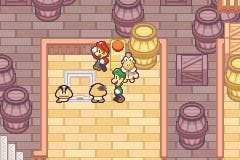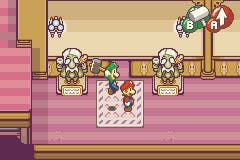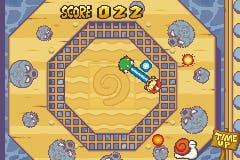Mario & Luigi: Superstar Saga
How come good games never sell?

Chances are you've never played a Mario RPG before. This doesn't make you a bad person. You may not even know you're missing out. After all, this peculiar union of prototypical platform leads and the measured pace and heavy narration of a role-playing game almost never made it over the Atlantic in the first place. Super Mario RPG, an isometric title using ACM graphics techniques pioneered in games by Rare, was originally developed as a dream collaboration between Nintendo and Squaresoft, but despite glowing reviews in Japan and the US it was never released in the UK or Europe. Something I've been moaning about for years.
Paper Mario, meanwhile, was given a ridiculously limited release right at the end of the N64's life span and similarly slipped underneath the radar. Intelligent Systems' 2D/3D pencil-drawn effort was stylistically probably more of a precursor to Mario & Luigi than the original SMRPG and was good enough to deserve a Cube-based update by the looks of Nintendo's latest release schedule, and it was certainly charmingly simple and accessible. If anything, it suffered more for its aspirations as an RPG than anything - criticised in homes where the A button is not to be mashed, and the B button brings up item lists more often than it recalls fireball attacks or run modifiers, for having the temerity to deviate from the generally accepted plan. That you could quite happily play it with your youngest was another vague problem.
Mario & Luigi, however, truly stamps its feet on a European Goomba's head, no doubt prancing upward to claim a Mushroom-shaped bonus for managing to please everybody. Instead of shoe-horning existing characters and ideas into a traditional RPG mould, developer Alpha Dream has done things completely the other way round - examining the characters' strengths and weaknesses, their tools, abilities and environments, and crafting an exceptional and humorous RPG that reinvents turn-based combat for the better and challenges the best Zeldas for sheer ingenuity. It has also developed one of very few GBA games this year to justify its price tag, and then released it in Europe. Sniff! What more is there to say? Fortunately rather a lot.
Super

At its core, Mario & Luigi is an action RPG with turn-based combat and a necessarily saccharine setup. But even here the game avoids cliché, as it turns out Bowser hasn't kidnapped Princess Peach, but Cackletta from the neighbouring Beanbean Kingdom has stolen the Princess' voice whilst disguised as a visiting dignitary, leaving her to utter strange symbols that blow up shortly after she blurts them out. Tasked with tracking down Cackletta and retrieving Peach's twinkling speech, Mario and Luigi are soon joined by an unlikely ally - Bowser! There's no love lost between them, but Bowser is clearly as pissed off as anybody about Cackletta's evil plan, as he can hardly turn up and kidnap the Princess if her every word is C4-tipped poison. Unfortunately their plan to unite against Cackletta quickly comes unstuck, but M and L will find they run into Bowser in a series of amusing confrontations throughout the game. Other familiar faces also pop up, and each line of dialogue and identifiable cameo is handled with a loving sense of humour - for example, it's a running joke that most people only recognise the Mario brothers when they see how high they can jump...
And jump they still do. Often together. Throughout Mario & Luigi, whether it's solving a simple puzzle in one of the game's dungeon-like environments or tackling a boss encounter, their original abilities and the two-man team dynamic drive the gameplay. Both characters can perform various moves at any given time, with the A button mapped to the foremost character's tricks and B to the secondary character. You can switch the order they move in with Start and cycle each character's individual abilities using the shoulder buttons. To begin with it's a very simple system, which you'll use to jump over lines of spikes (by having Mario jump with A and then having Luigi quickly follow with B) and operate things like moving platforms (hitting A and B to have the pair jump alternately), eventually combining tactics like squashing Mario with a hammer so he can crawl through small holes, or using your spin jump levitation technique in concert with some blustery tornadoes to float over bigger distances.
The puzzling and exploration rely on Mario and Luigi's unique abilities and how they work together, and like Zelda the game gradually teaches you how to combine abilities through non-player-character tutorials. In fact the structure overall is largely quite similar to Zelda, with gradual revelations shooting the bolts off hidden doors that you may or may not have seen when you first ventured through an environment. Lines of dialogue and key events may tickle you into remembering nagging questions like "How was I meant to get past that hefty armadillo-lookin' fella back in the caves?", as additions like the brothers' hammers allow them to bash through to new areas, and Mario's flame hand allows him to light up Luigi's behind and drag them both like a battering ram through tougher surfaces.
Time is running out

Having likened the puzzling and exploration to Zelda though, it's also worth comparing the combat to Chrono Trigger. At least to some extent... All right, it doesn't share a huge amount in common, but it does share one very obvious and crucial element - you can pick your fights. There will obviously be occasions when you're forced to do battle with a particular enemy for narrative reasons, or a piece of scenery obstructs your view and you stumble into trouble, but enemies here are drawn up as little sprites on the screen and with a bit of effort you can happily avoid running into them (or them running into you). Although you'll be woefully ill-equipped to deal with the tougher challenges down the road if you regularly avoid engagements, it's always nice to have the option. Random battles really are a tired formula and not having to worry whether the next step will cost you five minutes' tedious button jabbing is far better.
Perhaps ironically, random battles wouldn't feel like much of a chore in Mario & Luigi anyway, as it also features one of the most ingenious turn-based combat mechanics I've seen in ages (topping even the Wheel Of Fortune technique in the oft-overlooked Shadow Hearts). And all it needs to accomplish this is a little bit of the Mario series' traditional obsession with pixel-perfect precision and timing. But don't worry, it's actually very simple and not that stressful. For example, when the game starts, both characters' main attack is simply to bounce on their enemy's head. Although you can do this by stabbing A to select "Solo Attack" and stabbing it again a couple more times to select the Jump attack, you'll almost certainly carve more health off your enemy if you jump and strike A at precisely the point your character makes contact with his adversary. As the game goes on, you'll have to master different elements of timing, like waiting for your hammer weapon to start vibrating before hitting the strike button, and then there's the clever risk/reward system of Bros. Attacks - double-team efforts that see one brother batting the other through the air like a baseball, or bouncing on each other's head to gain speed and height. Although these undoubtedly cause more trouble, they also require very specific timing to do their worst (with an option to limit their effectiveness but benefit from slow-motion and button prompts), and they also gobble up "Bros. points", the game's equivalent of magical currency.
That alone is a battle system worth celebrating, but when you consider things like the ability to dodge enemy attacks, it sounds even better. Although cleverly it's very hard to dodge every single approach, with some practice and intuition you can come out of a battle relatively unscathed. And rather than make it more boring, dodging actually enhances the sense of excitement because you really have to be on your toes all the time - especially as you can't pause battles. What's more, it adds a sense of interest and trepidation when you face a new enemy and you don't know his attack patterns - a sensation that much of this Christmas' rank and file, point-and-obliterate stock could do with aspiring to convey.
Magic beans

It's one of the most compelling RPGs in recent memory, and virtually everything makes you smile. It's one of those game worlds that you just revel in, even when you're lost of stuck, chortling with unchecked delight as a bloated Mario waddles around with a stomach full of water, and then grinning as Luigi hops on his head for the first time to fire the water out of his mouth. You'll even start to smile knowingly as you see how familiar items and characters fit into the game world - mushrooms for health items, 1-ups to restore fallen comrades, question mark blocks in the air for power-ups and items, etc, and the guards on the Beanbean Kingdom border who make you skip over a wavering rope several times to raise a flag on a familiar-looking castle in the background...
Of course you'll also level up, agree to take on sub-quests, navigate mini-games as they justify passage through certain areas (like the ingenious mine cart/flashlight sequence), and perhaps even hook the cartridge up to your mate's GBA to play on the original arcade Mario Bros. game (all right, nobody has any patience for that one these days), but overall you'll just find it thoroughly absorbing, original and amusing. The level of satisfaction to be had completing team-based puzzles and outthinking the designers is something that very few other games this year have delivered (Prince of Persia maybe). It's a modern masterpiece, with each moment brought to life by rousing renditions of classic Mario tunes backed by a collection of original pieces (that they seamlessly brush shoulders with such a classic soundtrack is almost worthy of a point on its own), and surprisingly stomachable dialogue that's funny as often as it is lovably childish, as Mario and Luigi "Wahoo!" their digitised way through many hours of lavishly detailed adventure.
Even played on a Game Boy Player and a massive television, the Starfields and outlandish surroundings of the daft-sounding Woohoo Hooniversity are vividly realised and recognisable, easy on the eye and populated with colourful, imaginative characters. The brothers themselves are surprisingly emotive for a pair of hop 'n' squatting plumbers, largely thanks to their sizeable character sprites and finely detailed animation (right down to Luigi opening Mario's mouth to stuff it with a 1-up mushroom and revive him), and some of the boss characters are wonderful, like the mountaintop monster holding the secret to one of the game's most entertaining original characters - the prince of the Beanbean Kingdom.
One Of The Best...

On the whole, it's a game that I have very few reservations about recommending. There are times when the camera sometimes makes it a little difficult to judge the perspective properly for switches or jumps, and there are times when a particular team ability requires you to move around on a narrow platform to find the necessary space, but the inconvenience of having to retrace a few steps or move around a bit is rarely noteworthy (and it's never fatal or particularly damaging, either). More significant is that with so many abilities and so few buttons, plus the need to regularly switch characters, there is a tendency to confuse your fingers into jabbing the wrong thing. Quite often after the first few hours I found myself having to think quite hard about which character needed what, where and when. Besides occasionally fumbling the buttons though, it's a very difficult game to fault.
Of course, veterans of our handheld reviews will know that many a game has put in a top performance only to fall at the final hurdle - a big, spiky multicoloured hurdle marked "longevity" - and certainly there is a worry as you play through the early realms of Mario & Luigi that it's all going to come to a neat and compact conclusion within a fistful of hours. It's quite linear to begin with, and the map doesn't look all that big, but after a few hours it opens up and things become a lot less straightforward. Truth be told, estimates on playtime vary, and it really depends on how thorough you plan to be, but between 15 and 25 hours is probably about right, and the important point is simply that it's a Game Boy game not only with a decent length but also a reasonable prospect of replay value. I will certainly come back to this, if only to remind myself that "RPG" can mean a steady and accessible quest married to a celebration of simple and ingenious design.
And to be fair, that brings with it a small caveat. Fans of strictly traditional RPGs, where the most energetic or reaction-based aspect of the whole enterprise is ripping the cellophane off and vigorously digesting the manual, probably won't find what they're looking for here. For everyone else though, it gets three whole OOTBs - it's One Of The Best GBA games of the year, Nintendo games on the GBA, and RPGs in existence. Simple, fun and rewarding, this is for everyone who ever ogled but never played the original Mario RPG, and everyone else besides...

